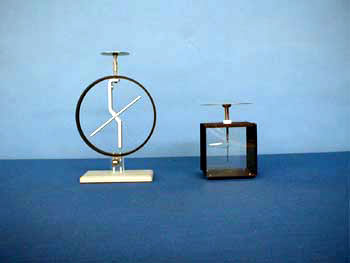Demos: 5A-06 Electroscopes

Two types of electroscopes are available – gold leaf and Braun. Each works on the same principle: the conductor to which the vane or leaf is attached is given a charge. The charge distributes itself along the conductor and because the leaf (or vane) is free to move, it will swing outward from its support, the amount of swing depending on the strength of the charge. If another charged object is brought near, the sign of the latter can be determined by noting whether the leaf (vane) swings further out or begins to collapse. Thus, if the initial charge sign is known, an unknown may be determined.
Directions: Ground the electroscope by touching the knob or plate. If you have dry skin, you might need to moisten your fingers to make good electrical contact. (Good grounding is indicated by a completely collapsed leaf or vane.) Once the electroscope is grounded, charge a rod (glass or ebonite) by friction and bring it near the knob of the electroscope. If you wish to charge the electroscope by contact, rub the rod along the knob until the vane or leaf has moved appreciably. (Because the rod is an insulator, the charges do not move along the rod. Therefore, to transfer the charge from the rod to the knob, you must rub it back and forth on the knob to attain maximum transfer.) If another charged rod of opposite sign is brought near the knob, the vane will begin to collapse. (If conditions are right, you might be able to show that the fur, for example, attains a charge opposite to that of the ebonite rod. After charging the electroscope by contact with the rod, quickly bring the fur near the knob. The charge leaks off the fur rapidly, so this part of the demonstration does not always work well.)
If charging by induction, hold the rod near the knob, but not touching, so that the vane stands out. Keeping the rod in position, touch the knob to ground it. Remove your finger, THEN remove the rod. The electroscope will now have a charge opposite to that of the rod.
Suggestions for Presentation: As in most electrostatic experiments, good insulation and dry air are important. The electroscopes will be set on rubber sheets to minimize leakage to the lecture table and the charging accessories are housed in an oven to keep them dry.
The electroscopes are devices to detect charge, but to the novice, the evidence that the electroscope’s action is evidence of an electrical force may not be entirely obvious. Begin by touching an uncharged rod to the electroscope knob to demonstrate that their is no visible interaction. Then rub the rod briskly and show that the electroscope responds to this new configuration. We call the entity that caused this interaction an “electrical charge.” Other, more sophisticated, experiments are needed to determine exactly what constitutes this charge.
Applications: There are a number of natural “electroscopes” in the environment. If you are charged, for example, items will be attracted to you, a phenomenon often called “static cling.”
Last Updated: Nov 30, 2023 11:25 AM